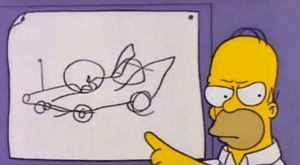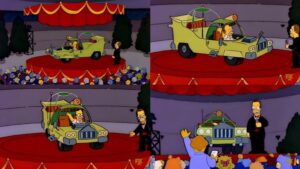There’s a famous episode of the The Simpsons where Homer is invited to design a car.Yes, him. An average American, with no experience, put in charge of the design department of a car manufacturer simply because he “represents the people.” They give him free rein, no limits, no filters. The result? A catastrophic, ridiculous, and extremely expensive car called “The Homer.” So absurd that it causes the company to go bankrupt within minutes of its presentation.
It’s funny, of course. But it’s also a perfect parable of what happens when design is excluded from decision-making processes.

The idea behind the episode is that all you have to do is ask a “user” what they want, and they’ll tell you. Just listen, execute, build. The problem? People don’t always know what they want. Or rather: they know what they feel they want, but often need someone to help them turn that intuition into something concrete, coherent, usable. In a word: designed. That’s where design comes into play.
In our field, it often happens that design is treated as an aesthetic to be added at the end. “Then we’ll have the designer fix it up,” as if it were a cosmetic step, a finishing touch after strategic choices have already been made elsewhere. But if you take away the designer’s opportunity to participate from the start – if you exclude them from objectives, constraints, real problems – what you get is not a beautiful product: it’s a wrong product with a nice interface.
“The Homer” is exactly that. A hodgepodge of personal requests: two separate domes, fuzzy carpet, a horn that plays La Cucaracha, an outrageous price. It’s the embodiment of “let’s put everything we can think of.” No hierarchy, no analysis of real needs, no intelligent compromise between desirable, feasible, and sustainable. In short: zero design.
The paradox is that the technical team in the episode exists. There are engineers, designers, people trying to warn Herb Powell (Homer’s half-brother and CEO of the company) that the direction is crazy. But Herb insists: Homer must have total control. And in doing so, he destroys everything.
If you’re a designer working in a tech environment, this scene feels familiar. How many times does it happen that the client, or the manager, or the product owner dictates the guidelines based on “what they like” or “what a friend said”?
The truth is that designing doesn’t just mean listening. It means interpreting, translating, validating. It means knowing when to say no. And above all, it means being there before the product exists, not just afterwards.

This is not just a ridiculous car from The Simpsons, but a living metaphor for many digital projects. Ideas born perhaps with the best intentions, but without a real design process. Projects built on the basis of “let’s do this because the client asks for it,” without anyone taking the time to understand if that “this” really makes sense for the end user.
That’s why that old episode seems more relevant than ever. Because it speaks, ultimately, of what happens when design is not listened to. When it’s believed that having a vision and a budget is enough, and the rest will sort itself out. Spoiler: it doesn’t happen. And even if failure isn’t always as spectacular as in the cartoon, the result is often similar: wasted time, confused users, wasted resources.
LINK to the episode -> https://www.youtube.com/watch?v=WPc-VEqBPHI&t=1s

